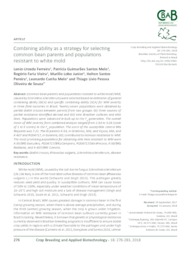Combining ability as a strategy for selecting common bean parents and populations resistant to white mold.
Combining ability as a strategy for selecting common bean parents and populations resistant to white mold.
Author(s): FERREIRA, L. U.; MELO, P. G. S.; VIEIRA, R. F.; LOBO JUNIOR, M.; PEREIRA, H. S.; MELO, L. C.; SOUZA, T. L. P. O. de
Summary: Common bean parents and populations resistant to white mold (WM, caused by Sclerotinia sclerotiorum) were selected based on estimates of general combining ability (GCA) and specific combining ability (SCA) for WM severity in three field nurseries in Brazil. Twenty-seven populations were obtained by partial diallel crosses between parents from two groups: GI) three sources of partial resistance identified abroad and GII) nine Brazilian cultivars and elite lines. Populations were advanced in bulk up to the F6 generation. The overall mean of WM severity from combined analysis ranged from 2.83 to 5.03 (scale of 1 to 9 scores) in the F6 population. The score of the susceptible control BRS Requinte was 7.21. The GI parents K-59, in Oratórios, MG, and Viçosa, MG, and K-407 and PI204717, in Goianira, GO, contributed to increase resistance to WM. The most promising populations for obtaining elite lines resistant to WM were K-59/BRS Executivo, PI204717/BRS Campeiro, PI204717/Jalo Precoce, K-59/BRS Radiante, and K-407/BRS Cometa.
Publication year: 2018
Types of publication: Journal article
Unit: Embrapa Rice & Beans
Observation
Some of Embrapa's publications are published as ePub files. To read them, use or download one of the following free software options to your computer or mobile device. Android: Google Play Books; IOS: iBooks; Windows and Linux: Calibre.
Access other publications
Access the Agricultural Research Database (BDPA) to consult Embrapa's full library collection and records.
Visit Embrapa Bookstore to purchase books and other publications sold by Embrapa.

